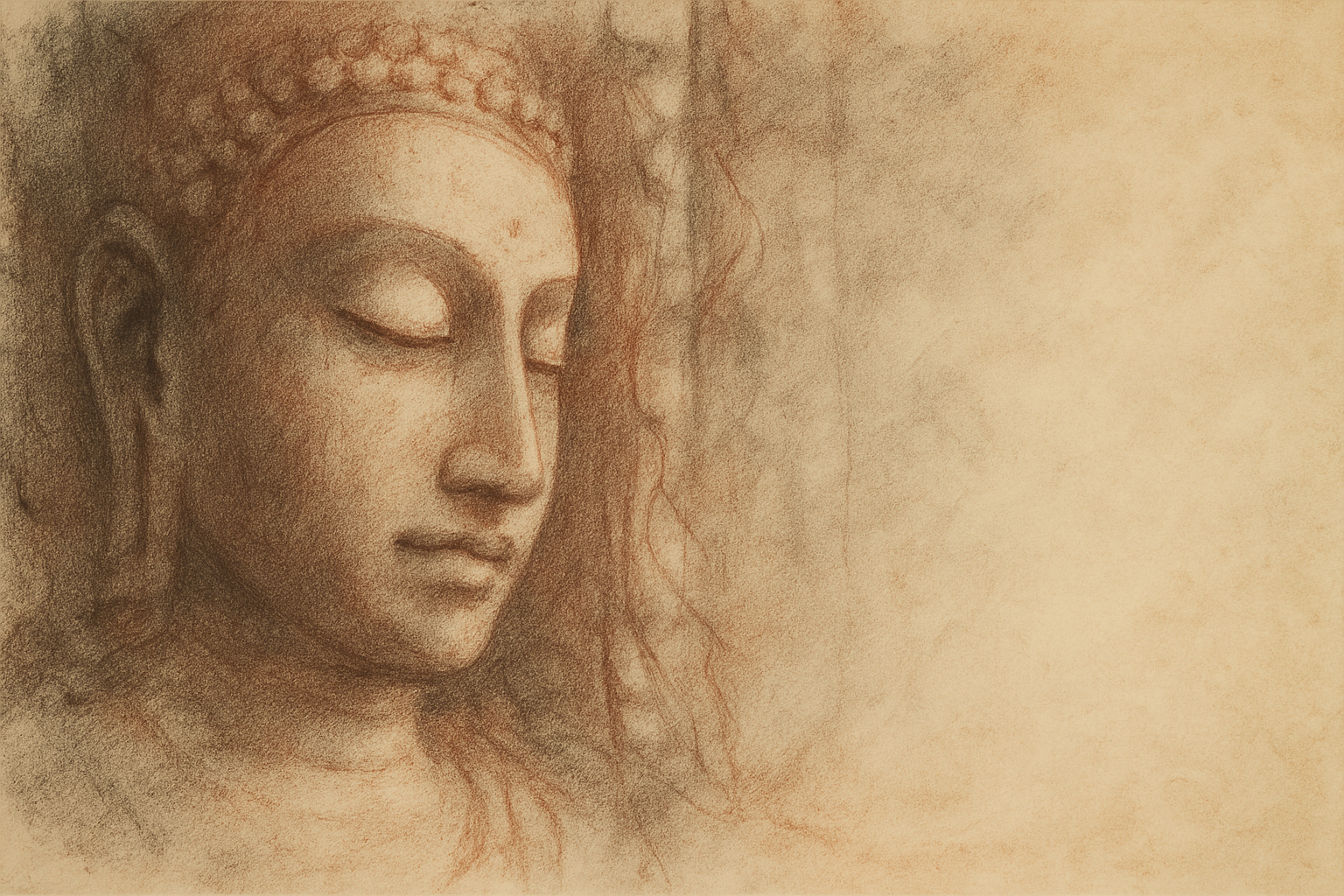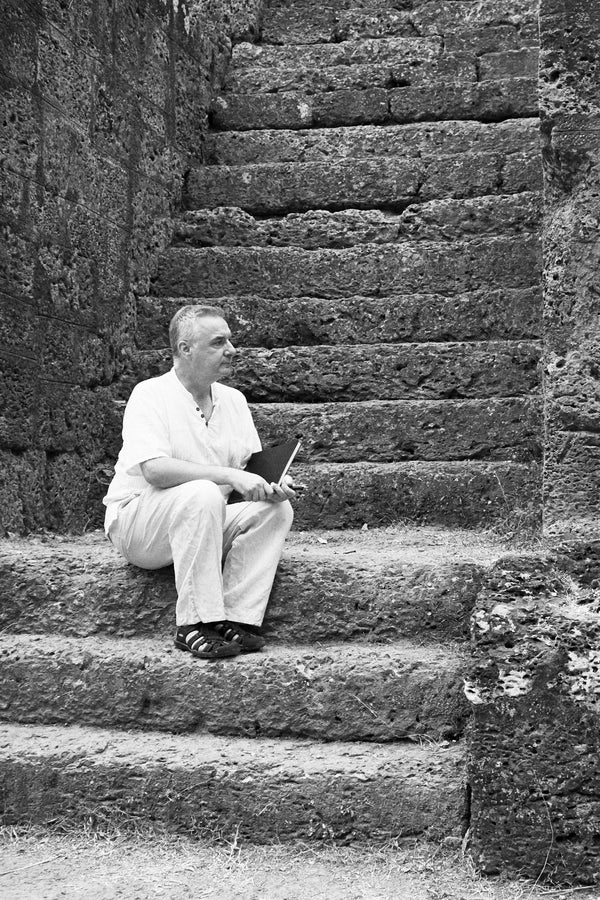Complimentary worldwide shipping on orders over $400 · No import tariffs for most countries
Complimentary worldwide shipping on orders over $400 · No import tariffs for most countries

The Stillness That Looks Back at You
3 min read
Sanctuary of Meaning · Artist’s Journal
by Lucas Varro
He who sees the Dharma sees me.
—The Buddha
Beneath the leafy hush of Preah Pithu, or crouched in the shadowed vaults of Bayon, I have stood many times before the carved image of the Buddha—stone eyelids lowered in eternal meditation, mouth curved in that soft, untroubled smile. And always, when I linger long enough, something within me begins to slow, to hush, to open.
Not because I know every mudrā. Not because I can name the dynasty that shaped each fold of robe. But because the stillness in the stone begins to awaken the stillness in me.
These are not portraits in the Western sense. They are thresholds—faces through which the timeless looks back.
The Buddha’s image—so instantly recognisable today—is often spoken of as universal. His seated posture, the gentle inclination of his gaze, the upright clarity of his form—these have become visual prayers, repeated in every corner of the world. But the deeper I walk among the temples of Angkor, the more I realise that each Buddha is also profoundly of this place. His features are not generic; they are Khmer. The broad, almost sensual mouth. The balanced tension between earth and sky. The soft lion-throned stillness. These are not universal abstractions. They are local sanctities. They are Cambodian.
And yet, the paradox remains: even as the Buddha’s face reveals the soul of a culture, it somehow exceeds it. This is the mystery of sacred form—it is at once deeply rooted and wholly beyond. A Buddha at Banteay Chhmar does not resemble one at Borobudur. And yet both are vessels of the same silence.
stone curls spiraling
toward the breath before all breath—
nothing, deeply seen
When I first began photographing these figures, I was drawn to their weathering. The worn earlobes. The collapsed eye. The moss like green fire across a shoulder. These imperfections did not obscure the sanctity—they revealed it. This was not a stillness frozen in marble. It was a stillness breathing, softened by time into greater truth.
Later, I turned my attention to the origins. I read of how, for centuries, the Buddha was not depicted at all. In early shrines, he appeared only through absence—an empty seat, a footprint, the shade of a Bodhi tree without a sitter. This was not iconoclasm. It was reverence. Perhaps no form was thought worthy to hold such presence.
And then, one day, the Buddha stepped into form.
Somewhere near the dawn of the Common Era, his image emerged in Gandhara and Mathura—two worlds speaking two different artistic tongues. In Gandhara, he wore the curled hair and draped folds of a Roman god. In Mathura, his body shimmered beneath close-clinging robes, sensuous and translucent as silk. One was Greco-Buddhist, the other deeply Indian. And yet—both became him.
Over time, these early images converged. The curls coiled tighter. The eyes lowered. The topknot became the cranial bump. A canon emerged—not imposed, but revealed: the lotus posture, the hand touching the earth, the monk’s robe falling with gravity and grace. These were not decorative choices. They were visual dharma. Each element a glyph of awakening.
What moves me most is the restraint.
The face must not become too specific. The hands must speak a known vocabulary. There is no room here for artistic vanity. The sculptor’s task is not to innovate, but to disappear—to shape a form so faithful that the formless can pass through it.
And yet, within this discipline: nuance. Variation. A thousand subtle devotions.
A Khmer Buddha smiles differently than a Sukhothai one. A figure from Lhasa carries the lineage of both India and China. A Bodhisattva in Kyoto echoes Avalokiteśvara, but with the softened eyes of the East. Every face is a regional prayer, a cultural hymn offered to the one who turned the wheel.
At Angkor, the Buddha sometimes appears as Lokeshvara—the Lord of Compassion—his head adorned with miniature Buddhas, each gaze a jewel of mercy. Sometimes he sits alone in narrow niches, worn smooth by centuries of incense, breath, and rain. Sometimes he towers at the centre, lion-throned in the holiest chamber. But always, he is more than image.
He is a mirror.
For what we recognise in the Buddha is not only him—it is the stillness we forgot we carried. The gaze turned inward. The breath that watches itself. That is why his eyes are half-closed—not to retreat from the world, but to see beyond it.
We are conditioned to think the spiritual image is something to be looked at. But the deeper truth is this: the Buddha image looks at us.
And in its silence, it asks—
Are you still enough to enter?
—
In every sanctuary,
a face turned inward
teaches the wind
how to be still.
The Stillness That Sees – Carvings of the Buddha at Angkor
Photographs from the Spirit of Angkor series by Lucas Varro
Among the broken corridors and sacred chambers of Angkor, the Buddha endures—not in proclamation, but in presence. Carved in stone with infinite quietude, these figures gaze not outward, but inward, inviting the viewer to step into a silence beyond time. Faces worn smooth by centuries of wind and devotion, hands resting in the mudra of stillness or blessing—each image is less a monument than a meditation.
At Angkor, Buddhist carvings reveal a shift in the sacred landscape: from conquest to compassion, from power to peace. Whether nestled in shadowed niches or centred beneath naga hoods, these Buddhas do not speak—but they remain. Radiant in erosion. Unmoving in light.
In this contemplative collection from the Spirit of Angkor series, Lucas Varro brings his large and medium format analogue cameras into intimate dialogue with these carved sanctities. Each photograph—shaped through long exposure, chiaroscuro, and hand-toning—honours not only the image of the Buddha, but the awareness it embodies. A gaze returned through stone. A breath suspended in dust and gold.
Printed in limited editions on museum-grade Hahnemühle Bamboo paper, each work is accompanied by a Collector’s Print Package including poetic writings, curatorial insights, and field notes from the artist’s silent encounters with the sacred.
This is a collection of sacred stillness—where the Buddha is not only carved in stone, but revealed in light.
Join My Studio Journal
Receive occasional letters from my studio in Siem Reap—offering a glimpse into my creative process, early access to new fine art prints, field notes from the temples of Angkor, exhibition announcements, and reflections on beauty, impermanence, and the spirit of place.
No noise. No clutter. Just quiet inspiration, delivered gently.
Subscribe and stay connected to the unfolding story.

Join My Studio Journal
Receive occasional letters from my studio in Siem Reap—offering a glimpse into my creative process, early access to new fine art prints, field notes from the temples of Angkor, exhibition announcements, and reflections on beauty, impermanence, and the spirit of place.
No noise. No clutter. Just quiet inspiration, delivered gently.
Subscribe and stay connected to the unfolding story.






